Acousto-optic Modulator for High-power Pulsed Fiber Laser 114
Acousto-optic Modulator for High-power Pulsed Fiber Laser
Abstract:
The present invention relates to an acousto-optic modulator for high-power pulsed fiber lasers, including an input pigtail, a collimating lens, an acousto-optic device, a focusing lens, and an output pigtail. The input pigtail is placed at 3.7° with the horizontal plane, and the output tail The fiber and the horizontal plane are placed at 0° or 3.7°, the input pigtail and collimating lens are installed together to form an input fiber collimator, and the output pigtail and focusing lens are installed together to form an output fiber collimator, and then the input, The output fiber collimator and the acousto-optic device are assembled as a whole; a narrowband filter can be placed between the acousto-optic device and the output fiber collimator, and the input fiber collimator and output fiber collimator can be combined into one Fiber collimator, add a narrow band high reflector. The invention effectively improves the mechanical stability of the laser system, can effectively suppress the nonlinear effect in the doped fiber, and realizes high-power, narrow-spectrum pulsed laser output by coating different components.
Background technology
Q-switched double-clad fiber lasers have many advantages such as low price, compact structure, high efficiency, narrow line width, tunable wavelength, etc., in many fields such as remote sensing, ranging, medical, military, industrial processing, nonlinear optical applications, etc. Widely used.
At present, the commonly used method to obtain high-power pulses through double-clad fiber is that the main oscillator provides a “seed” pulse, and then injects it into the double-clad fiber amplification (M0PA) to obtain it. The seed oscillator (M0) often uses a mode-locked laser or Traditional Q-switched solid-state lasers [see Prior Art: CLE02002, CThX3, 591]. A simpler method is to insert a Q-switched device directly into the double-clad fiber laser cavity to obtain high peak power and high energy lasers. Pulse [see Prior Art: CLE02003,626]. Although the above two methods can obtain high-power pulsed laser output, it is not easy to realize the full fiber laser of the laser.
In order to realize the full fiberization of the fiber laser, one method is to use a modulated semiconductor laser as the M0 in the M0PA structure, that is, a multi-stage fiber amplification structure [see Prior Art: Opt. Lett., 30 (24), 2005, P3299] . The disadvantage of this method is that the output power of the seed source is small, and multi-stage amplification is required to achieve the required power, and an optical isolator is required before each stage of amplification, which easily produces nonlinear effects in the fiber, which limits its output power. The further increase, and the cost is higher. Another method is to insert a pigtailed Q-switched device into the double-clad fiber laser cavity. This method also realizes the full fiberization of the laser, making the laser more compact, but it is easy to carry at high power. The new problem of self-excited oscillation in the cavity also limits the further increase of laser power.
The purpose of the present invention is to overcome the above-mentioned problems in the prior art and provide an acousto-optic modulator for high-power pulsed fiber lasers. The acousto-optic modulator of the present invention has pigtail input and output, which can easily realize the All fiber optic. Corresponding treatment of the end face of the pigtail can suppress the self-excited oscillation in the doped fiber, so as to achieve high-power pulsed laser output, and achieve narrow-spectrum laser output by coating different components.
The structure of the acousto-optic modulator for high-power pulsed fiber lasers of the present invention is shown in Figure 1, Figure 2 and Figure 3.
Acousto-optic modulator for high-power pulsed light, including input pigtail 101, collimating lens 102, acousto-optic device 103, focusing lens 104 and output pigtail 105. Input pigtail 101 is placed at 3.7° with the horizontal plane, and output The pigtail 105 is placed at 0° to the horizontal plane, the input pigtail 101 and the collimating lens 102 are installed together to form an input fiber collimator, and the output pigtail 105 and focusing lens 104 are installed together to form an output fiber collimator, and then the input The fiber collimator, the output fiber collimator, and the acousto-optic device 103 are assembled as a whole 100. The input pigtail 101 and the output pigtail 105 are fused with fiber end caps and each ground into an oblique 8° plane, and A broadband antireflection film is plated on the oblique 8° plane of the input pigtail 101, and a narrowband transmission film is plated on the oblique 8° plane of the output pigtail 105. As shown in Figure 1.
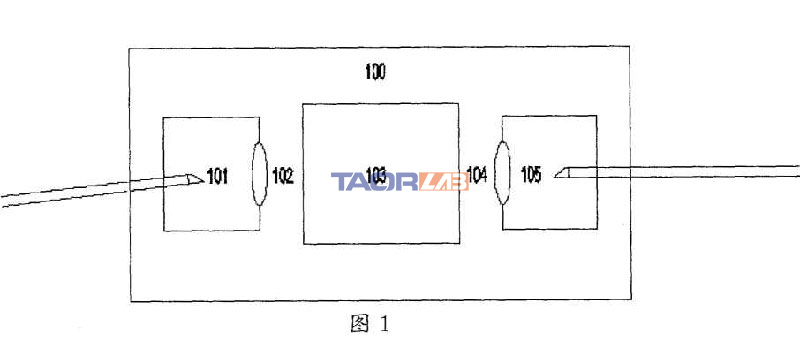
The acousto-optic modulator of another structure of the present invention is shown in Fig. 2. The input pigtail 101 is placed at 3.7° with the horizontal plane. The input pigtail 101 and the collimating lens 102 are installed together to form the input fiber collimator. The ends of the fiber 101 are fused with fiber end caps and each ground into an oblique 8° plane, and a broadband anti-reflection coating is plated on the oblique 8° plane. The output fiber formed by the acousto-optic device 103, the output pigtail 105 and the focusing lens 104 is collimated A narrow-band filter 106 is placed between the devices, and the output pigtail 105 is placed at 3.7° from the horizontal plane. A broadband anti-reflection coating is plated on the oblique 8° plane of the output pigtail 105. The acousto-optic device 103 and the narrow-band filter 106 are installed together. , And the narrow-band filter 106 and the first-order diffraction direction of the acousto-optic device 103 are placed at a corresponding angle, so that the narrow-band filter 106 has the maximum transmittance to the set wavelength, and cannot reflect other wavelengths of light back to the acousto-optic The device 103 enters the input fiber collimator, and then the input fiber collimator, the output fiber collimator and the acousto-optic device 103 and the narrowband filter 106 are assembled as a whole 100.
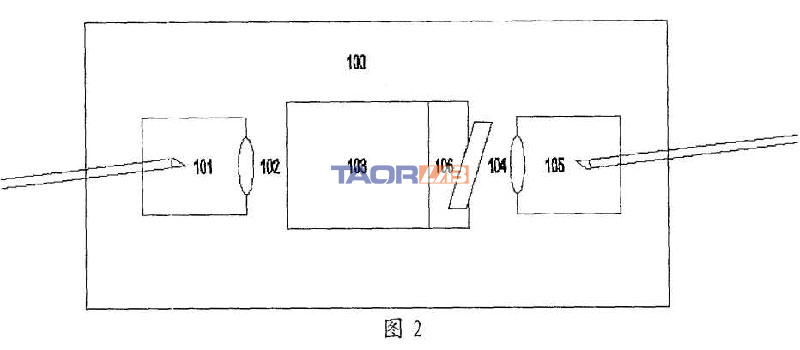
Another structure of the acousto-optic modulator of the present invention is shown in Figure 3. The input pigtail and output pigtail are combined into a pigtail 301, the focusing lens 104 is removed, and a narrow-band high reflector 107 is added. The pigtail 301 is connected to the horizontal plane. Place it at 3.7° and install it with the collimating lens 102 to form a fiber collimator. The end of the pigtail 301 is fused with a fiber end cap and ground to an 8° bevel, and the bevel is plated with a broadband antireflection coating, acousto-optic device 103 And the narrow-band high-reflective mirror 107 are installed together, and the narrow-band high-reflective mirror 107 is perpendicular to the first-order diffracted light through the acousto-optic device 103, and then the two parts are assembled into a whole 100.
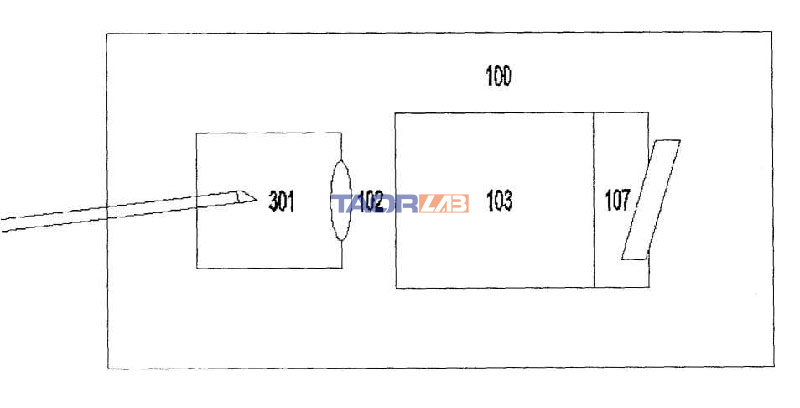
The three acousto-optic modulators of the present invention are free of internal adjustment, which greatly improves the mechanical stability of the entire system.
The 1064±0.5nm anti-reflection coating is plated on the 8-degree oblique surface of the output pigtail 105. Only for Yb-doped fiber lasers, the anti-reflection coating of the corresponding wavelength can be selected according to the working wavelength of the doped fiber. The anti-reflection coating is highly transparent to the 1064+0.5nm laser, ensuring that the laser of this wavelength forms an oscillating output in the cavity, and the light of the other wavelengths obliquely has a large reflection loss, thereby narrowing the width of the laser output spectrum.
The narrow-band filter 106 is placed at an angle with the acousto-optic modulator 103, and the surface is coated with a narrow-band transmission film. The narrow-band transmission film of the corresponding wavelength can be selected according to the working wavelength of the gain fiber. For example, the Yb-doped fiber laser is coated with 1064± The 0.5nm narrow-band transmission film ensures that the laser with the set wavelength will form an oscillating output in the cavity, while obliquely facing the light of the other wavelengths has a large reflection loss, thereby narrowing the width of the laser output spectrum.
The surface of the narrow-band high reflection mirror 107 is coated with a narrow-band high-reflection film. The narrow-band high-reflection film of the corresponding wavelength can be selected according to the working wavelength of the gain fiber. For example, for a Yb-doped fiber laser, a 1064+0.5nm narrow-band high-reflection film is coated , Placed perpendicular to the first-order diffraction direction of the acousto-optic device, to ensure that the laser of the set wavelength forms an oscillating output in the cavity, and the light of the other wavelengths has a large transmission loss, thereby narrowing the width of the laser output spectrum.
The invention is an acousto-optic modulator with pigtail input and output, easy to realize all-fiber fiber laser, which effectively improves the mechanical stability of the laser system, can effectively suppress the nonlinear effect in the doped fiber, and can be used in different components The method of coating film to achieve high-power, narrow-spectrum pulsed laser output.
Specific implementation
As shown in Figure 4, the pigtailed 915nm pumped semiconductor laser 401 is fused to the total reflection fiber grating 402, the total reflection fiber grating is fused to the gain fiber 403, the gain fiber is fused to the input pigtail 404, and the input pigtail is fused to the fiber end The cap is ground into an 8° inclined surface, then a broadband antireflection coating is plated, and it is placed at 3.7° from the horizontal. The laser generated by the gain fiber passes through the input pigtail 404 and the collimating lens 405 to form a collimated beam into the acousto-optic The device 406 generates Bragg diffraction, and the diffracted first-order light is coupled into the pigtail 408 through the focusing lens 407. The output pigtail 408 is fused with a fiber end cap, ground into an 8° bevel, coated with a narrow-band anti-reflection coating, and placed at 0° from the horizontal plane. In this way, only the narrowband wavelength set in the first-order diffracted light is allowed to enter the output pigtail 408, while reflecting other wavelengths, the reflected other wavelengths will not enter the output pigtail through the acousto-optic device, and the output pigtail 408 and part of the The reflective fiber grating 409 is spliced. In this way, the fiber gratings 402 and 409 form a resonant cavity. Because the output pigtail 408 and the oblique 8° surface are coated with a narrow-band anti-reflection coating, the excitation of other wavelengths is suppressed, so that the pulse fiber laser formed in this way has a narrow linewidth output. No nonlinear wavelengths appear. We use this structure to obtain an average output power of 2W at a frequency of 20kHz, a pulse width of 40ns, and a peak power of 2.5kW. Fig. 5 shows the output spectrum of the acousto-optic modulator using the present invention, and comparing it with the spectrum of the same power level generated by the ordinary acousto-optic modulator, it is obvious that the spectrum is broad and has Raman wavelengths.
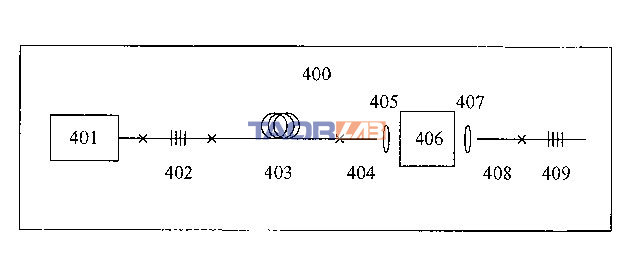
Figure 4: A schematic diagram of a specific embodiment of the present invention.
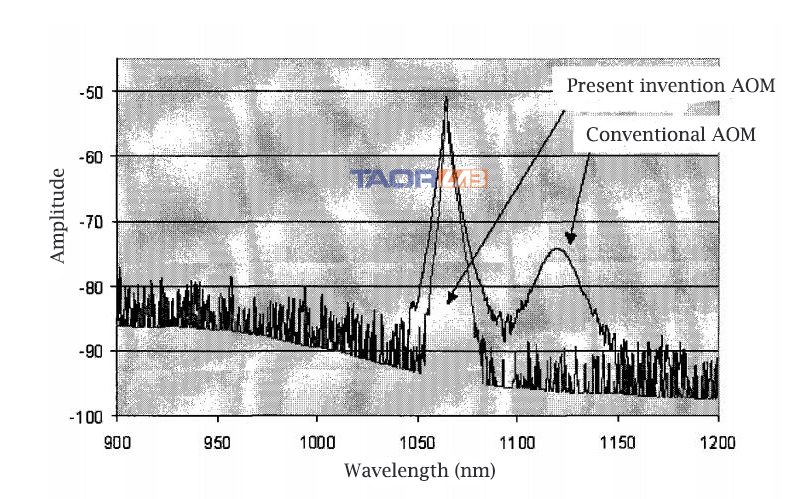
Figure 5: A graph showing whether to use the output spectrum of the acousto-optic modulator of the present invention and comparing the spectrum with the same power level generated by a common acousto-optic modulator.
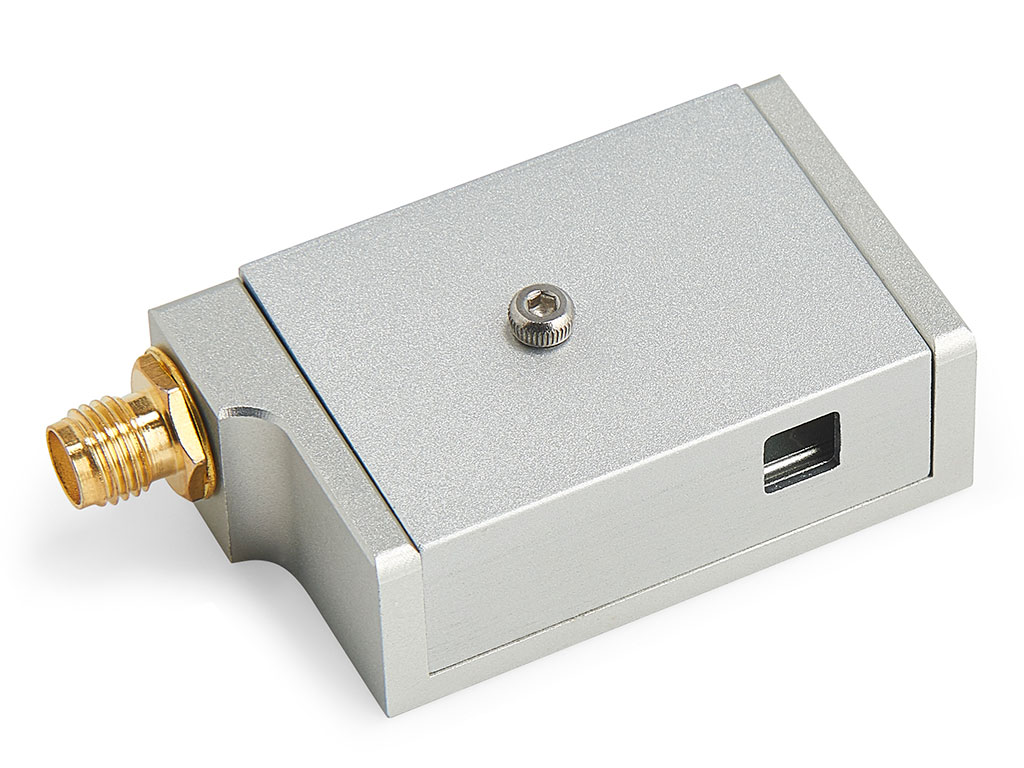
oaiuBOcXdbm
AgivWtFc
cyDTShioKtxRgflm
Can you be more specific about the content of your article? After reading it, I still have some doubts. Hope you can help me.
Thanks for sharing. I read many of your blog posts, cool, your blog is very good.
Thank you for your sharing. I am worried that I lack creative ideas. It is your article that makes me full of hope. Thank you. But, I have a question, can you help me? https://www.binance.com/ES_la/register?ref=T7KCZASX
Your article helped me a lot, is there any more related content? Thanks!
Your article helped me a lot, is there any more related content? Thanks!
Your enticle helped me a lot, is there any more related content? Thanks!
I don’t think the title of your article matches the content lol. Just kidding, mainly because I had some doubts after reading the article.
Can you be more specific about the content of your article? After reading it, I still have some doubts. Hope you can help me.
I don’t think the title of your article matches the content lol. Just kidding, mainly because I had some doubts after reading the article.
Keep up the fantastic work! Kalorifer Sobası odun, kömür, pelet gibi yakıtlarla çalışan ve ısıtma işlevi gören bir soba türüdür. Kalorifer Sobası içindeki yakıtın yanmasıyla oluşan ısıyı doğrudan çevresine yayar ve aynı zamanda suyun ısınmasını sağlar.
Thanks for sharing. I read many of your blog posts, cool, your blog is very good. https://accounts.binance.com/ES_la/register-person?ref=T7KCZASX
Your point of view caught my eye and was very interesting. Thanks. I have a question for you.
Thanks for sharing. I read many of your blog posts, cool, your blog is very good.
Thank you for your sharing. I am worried that I lack creative ideas. It is your article that makes me full of hope. Thank you. But, I have a question, can you help me?
Can you be more specific about the content of your article? After reading it, I still have some doubts. Hope you can help me.
Your point of view caught my eye and was very interesting. Thanks. I have a question for you.
Your point of view caught my eye and was very interesting. Thanks. I have a question for you.
Your point of view caught my eye and was very interesting. Thanks. I have a question for you.
I don’t think the title of your article matches the content lol. Just kidding, mainly because I had some doubts after reading the article.
Your point of view caught my eye and was very interesting. Thanks. I have a question for you.
I don’t think the title of your article matches the content lol. Just kidding, mainly because I had some doubts after reading the article.
I don’t think the title of your article matches the content lol. Just kidding, mainly because I had some doubts after reading the article.
Revolutionize your weighing needs with BWER, Iraq’s top provider of weighbridge systems, featuring unparalleled accuracy, durability, and expert installation services.
Your article helped me a lot, is there any more related content? Thanks!
I don’t think the title of your article matches the content lol. Just kidding, mainly because I had some doubts after reading the article.
I don’t think the title of your article matches the content lol. Just kidding, mainly because I had some doubts after reading the article.
Hi there, I discovered your website by way of Google at the same time as searching for a similar matter, your website got here up, it appears to be like great. I have bookmarked it in my google bookmarks.
Appreciate it for this post, I am a big big fan of this website would like to go along updated.
Your point of view caught my eye and was very interesting. Thanks. I have a question for you. https://www.binance.com/en-IN/register?ref=UM6SMJM3
I truly appreciate this post. I¦ve been looking all over for this! Thank goodness I found it on Bing. You have made my day! Thank you again
At BWER Company, we prioritize quality and precision, delivering high-performance weighbridge systems to meet the diverse needs of Iraq’s industries.
Thanks for sharing. I read many of your blog posts, cool, your blog is very good.
Your article helped me a lot, is there any more related content? Thanks!
Great – I should certainly pronounce, impressed with your site. I had no trouble navigating through all tabs as well as related info ended up being truly easy to do to access. I recently found what I hoped for before you know it at all. Reasonably unusual. Is likely to appreciate it for those who add forums or something, website theme . a tones way for your customer to communicate. Excellent task..
Thanks for sharing. I read many of your blog posts, cool, your blog is very good.
Can you be more specific about the content of your article? After reading it, I still have some doubts. Hope you can help me. https://accounts.binance.com/de-CH/register?ref=UM6SMJM3
Your point of view caught my eye and was very interesting. Thanks. I have a question for you. https://accounts.binance.com/register?ref=P9L9FQKY
Your article helped me a lot, is there any more related content? Thanks!
I don’t think the title of your article matches the content lol. Just kidding, mainly because I had some doubts after reading the article.
Can you be more specific about the content of your article? After reading it, I still have some doubts. Hope you can help me.
I don’t think the title of your article matches the content lol. Just kidding, mainly because I had some doubts after reading the article.
Your article helped me a lot, is there any more related content? Thanks! https://www.binance.info/si-LK/register?ref=V2H9AFPY
Thank you for your sharing. I am worried that I lack creative ideas. It is your article that makes me full of hope. Thank you. But, I have a question, can you help me?
I’m still learning from you, while I’m trying to reach my goals. I certainly liked reading all that is posted on your site.Keep the posts coming. I enjoyed it!
Thanks for sharing. I read many of your blog posts, cool, your blog is very good.
Can you be more specific about the content of your article? After reading it, I still have some doubts. Hope you can help me.
Thank you for your sharing. I am worried that I lack creative ideas. It is your article that makes me full of hope. Thank you. But, I have a question, can you help me?
I love it when people come together and share opinions, great blog, keep it up.
Thanks for sharing. I read many of your blog posts, cool, your blog is very good.
Your point of view caught my eye and was very interesting. Thanks. I have a question for you.
I don’t think the title of your article matches the content lol. Just kidding, mainly because I had some doubts after reading the article.
Thanks for another informative web site. Where else could I get that kind of info written in such a perfect way? I’ve a project that I am just now working on, and I’ve been on the look out for such information.
I don’t think the title of your article matches the content lol. Just kidding, mainly because I had some doubts after reading the article.
Good write-up, I’m regular visitor of one’s website, maintain up the excellent operate, and It is going to be a regular visitor for a long time.
Everything is very open and very clear explanation of issues. was truly information. Your website is very useful. Thanks for sharing.
Wohh just what I was looking for, regards for posting.
Dead composed content material, Really enjoyed looking at.
Thank you for your sharing. I am worried that I lack creative ideas. It is your article that makes me full of hope. Thank you. But, I have a question, can you help me?
Thanks for sharing. I read many of your blog posts, cool, your blog is very good.
Your article helped me a lot, is there any more related content? Thanks!
Thanks for another informative web site. Where else could I get that type of info written in such an ideal way? I have a project that I am just now working on, and I’ve been on the look out for such information.
I’ve been absent for some time, but now I remember why I used to love this web site. Thanks , I will try and check back more often. How frequently you update your website?
Thanks for sharing. I read many of your blog posts, cool, your blog is very good.
Some truly interesting points you have written.Aided me a lot, just what I was looking for : D.
Can you be more specific about the content of your article? After reading it, I still have some doubts. Hope you can help me.
hello!,I really like your writing so much! share we keep in touch extra about your article on AOL? I require an expert on this area to unravel my problem. Maybe that’s you! Looking forward to see you.
Thanks for sharing. I read many of your blog posts, cool, your blog is very good.
Thanks for another great post. Where else could anybody get that kind of information in such a perfect way of writing? I have a presentation next week, and I’m on the look for such information.
I don’t think the title of your article matches the content lol. Just kidding, mainly because I had some doubts after reading the article.
Thank you for your sharing. I am worried that I lack creative ideas. It is your article that makes me full of hope. Thank you. But, I have a question, can you help me?
Networking is key in any business landscape Iraq Business News features events and conferences, providing opportunities to connect with other professionals and industry leaders in Iraq
The construction and real estate sectors feature prominently on BusinessIraq.com, with regular updates on major infrastructure projects, urban development initiatives, and property market trends. Our coverage includes detailed reporting on government tenders, private sector developments, and international construction partnerships. From residential projects to commercial developments, we track the building blocks of Iraq’s economic growth, providing valuable insights for industry stakeholders.
Understanding the complexities of Iraq’s market, BusinessIraq.com offers specialized reporting on trade policies, economic reforms, and market trends. Our platform features expert interviews with industry leaders, government officials, and economic analysts, providing valuable insights into Iraq’s business climate. Regular coverage of international partnerships, foreign investment initiatives, and cross-border trade agreements keeps our readers ahead of market developments.
The rapidly evolving financial sector receives dedicated attention on BusinessIraq.com, with regular updates on banking reforms, currency developments, and investment regulations. Our expert analysis covers everything from traditional banking to emerging fintech solutions, providing crucial insights for financial professionals and investors operating in Iraq’s market.
Your article helped me a lot, is there any more related content? Thanks!
I don’t think the title of your article matches the content lol. Just kidding, mainly because I had some doubts after reading the article.
Businesses looking to enter the Iraqi market can benefit from the expert commentary found on Iraq Business News. Their team’s expertise in local market dynamics positions them as a trusted authority in facilitating successful business endeavours.
Can you be more specific about the content of your article? After reading it, I still have some doubts. Hope you can help me.
Can you be more specific about the content of your article? After reading it, I still have some doubts. Hope you can help me. https://accounts.binance.com/es/register-person?ref=T7KCZASX
Thanks for sharing. I read many of your blog posts, cool, your blog is very good.
Thanks for sharing. I read many of your blog posts, cool, your blog is very good. https://www.binance.com/lv/register?ref=B4EPR6J0
Heya i am for the primary time here. I found this board and I find It really useful & it helped me out a lot. I am hoping to provide something back and help others such as you aided me.
Can you be more specific about the content of your article? After reading it, I still have some doubts. Hope you can help me.
Excellent blog here! Also your website loads up very fast! What host are you using? Can I get your affiliate link to your host? I wish my site loaded up as quickly as yours lol
Thanks for sharing. I read many of your blog posts, cool, your blog is very good. https://accounts.binance.com/join?ref=P9L9FQKY
Thank you for sharing with us, I think this website genuinely stands out : D.
Your point of view caught my eye and was very interesting. Thanks. I have a question for you.
Your point of view caught my eye and was very interesting. Thanks. I have a question for you.
Can you be more specific about the content of your article? After reading it, I still have some doubts. Hope you can help me.
Hi, I think your site might be having browser compatibility issues. When I look at your website in Safari, it looks fine but when opening in Internet Explorer, it has some overlapping. I just wanted to give you a quick heads up! Other then that, fantastic blog!
Pan American Travel được thành lập từ năm 2017, tự hào là một trong những đơn vị hàng đầu du lịch outbound Châu Mỹ, Châu Âu và nhiều quốc gia khác. Chúng tôi không ngừng nỗ lực mang đến các dịch vụ du lịch độc đáo với trải nghiệm văn hoá bản địa đắt giá nhất cho khách hàng.
I don’t think the title of your article matches the content lol. Just kidding, mainly because I had some doubts after reading the article.
Great work! That is the type of information that are supposed to be shared around the web. Disgrace on Google for not positioning this publish higher! Come on over and talk over with my web site . Thank you =)
Профессиональный сервисный центр по ремонту бытовой техники с выездом на дом.
Мы предлагаем:сервисные центры в москве
Наши мастера оперативно устранят неисправности вашего устройства в сервисе или с выездом на дом!
With havin so much content and articles do you ever run into any issues of plagorism or copyright violation? My blog has a lot of completely unique content I’ve either authored myself or outsourced but it appears a lot of it is popping it up all over the internet without my agreement. Do you know any ways to help stop content from being ripped off? I’d really appreciate it.
It is perfect time to make some plans for the future and it is time to be happy. I’ve read this post and if I could I desire to suggest you some interesting things or advice. Maybe you can write next articles referring to this article. I wish to read even more things about it!
I real pleased to find this website on bing, just what I was looking for : D too bookmarked.
Hello there! This article couldn’t be written any better! Reading through this post reminds me of my previous roommate! He always kept preaching about this. I will forward this information to him. Fairly certain he’ll have a good read. Many thanks for sharing!
The references and examples really add value.
You explained the fundamentals perfectly.
Join slotv Today and Claim Your $100 Welcome Bonus!
Start your journey at 21bit with an exclusive $100 bonus
just for signing up! As a new user, you’ll immediately unlock this bonus, allowing you to
explore a wide array of casino games, sports betting,
and more. With 21bit‘s
user-friendly platform and exciting promotions, you can enhance your
gaming experience right from the get-go. Sign up now, claim your $100 bonus, and get started on a
thrilling ride of wins and rewards!
At rummy, new players are
treated to a $100 bonus upon registration! This bonus gives
you the chance to explore all that rummy
has to offer, from thrilling casino games to exciting sports betting options.
Sign up today, claim your bonus, and start your gaming adventure with a
bang. The possibilities are endless with rummy!
Welcome to amon, the
ultimate destination for online gaming! New users can claim a $100 bonus just for registering, which they can use to explore a range of exciting games.
Whether you’re a fan of poker, blackjack, slots,
or sports betting, amon has something for everyone.
Sign up now, claim your $100 bonus, and get started on your
path to thrilling wins and unforgettable gaming
moments!
Join netbet Now and Claim Your $100 Bonus in Just a Few Steps!
Sign up for bizzo and get
an instant $100 bonus upon registration! The
process is fast and simple: create your account, log in, and the bonus will be credited to your account.
As a new player, this bonus gives you more
opportunities to try out a variety of games on the platform.
Join bizzo today, and your $100 bonus will be waiting for you!
Start strong with 32red‘s
$100 bonus for new players! Register today, and you’ll immediately be credited with a $100 bonus that you can use to explore the vast selection of casino games
and sports betting options available. With an easy-to-navigate platform and
exciting promotions, 32red
ensures an unforgettable gaming experience. Don’t wait—sign up now and claim your $100 bonus!
Get a $100 Bonus Right After Registering at 24bet!
Start Strong with a $100 Bonus at leon – Register
Today!
Sign up on patti now and claim your $100 bonus instantly!
New users can easily register and log in to receive this exciting welcome bonus.
It’s a great way to boost your starting balance and explore the wide variety of casino
games at patti. Don’t miss this opportunity – register
today and claim your bonus!
Can you be more specific about the content of your article? After reading it, I still have some doubts. Hope you can help me.